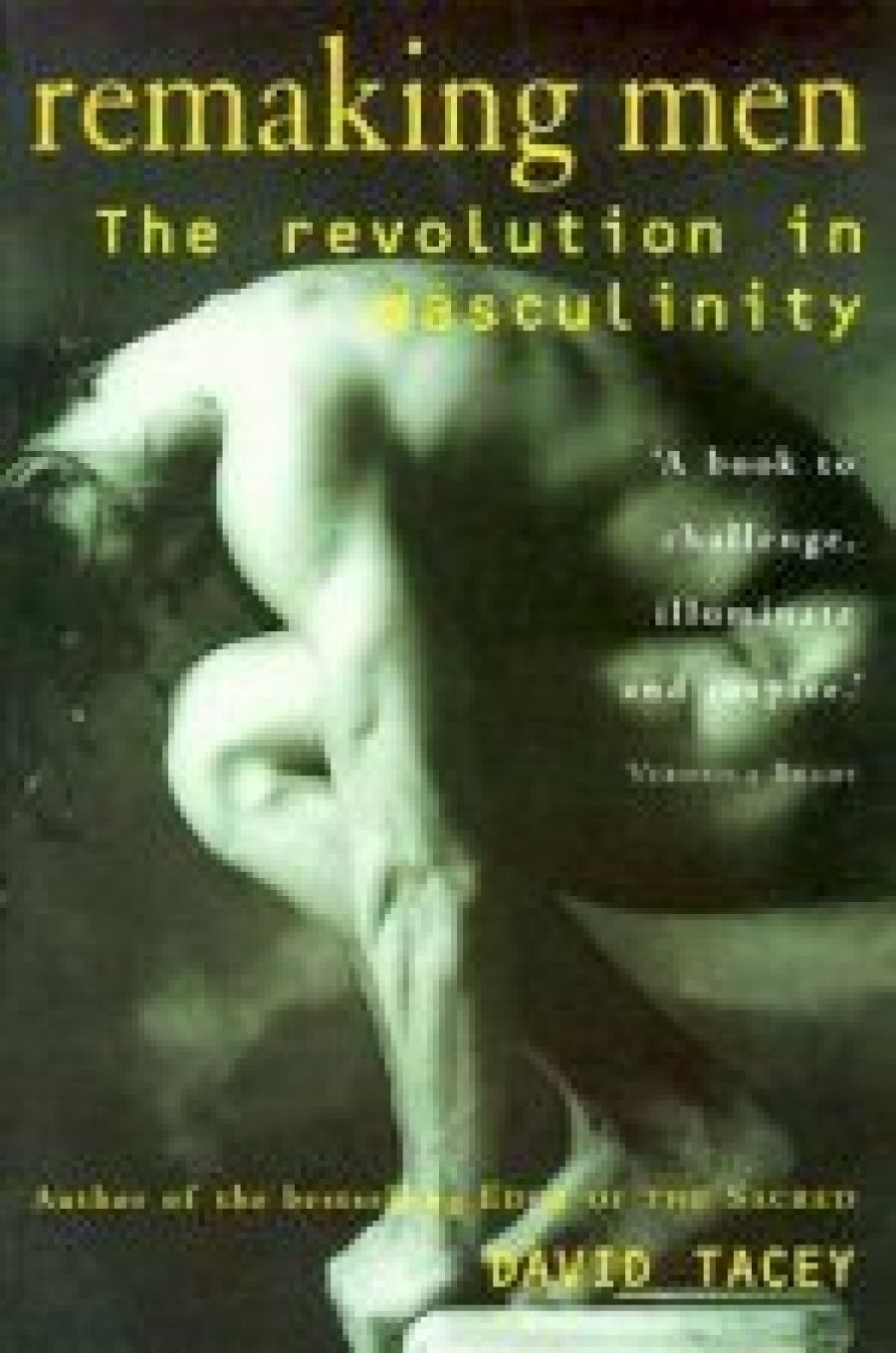
- Free Article: No
- Contents Category: Society
- Review Article: Yes
- Article Title: Men and Myth
- Online Only: No
- Custom Highlight Text:
Whatever happened to the men’s movement? Was it only a few years ago that we all gathered in the Dandenongs to bang drums, fashion spears, and – I quote from a flier advertising one such event – hug all night in ‘greased cuddle piles’. Now the tribes of management consultants, computer programmers and, well, wimps have retreated from view (to the chagrin of stand-up comedians everywhere) and the copies of Iron John litter the twenty cent tables of the second-hand bookstores.
- Book 1 Title: Remaking Men
- Book 1 Subtitle: The revolution in masculinity
- Book 1 Biblio: Viking, $19.95 pb., 222 pp
- Book 1 Readings Link: booktopia.kh4ffx.net/DVrJZ2
Yet despite its sillier aspects the men’s movement was and is of great significance as a pivotal moment in cultural politics. The men’s movement is the first movement in identity politics that did not spring from the political movement of an oppressed group (for example, women, non-whites). ‘What do they need a men’s movement for? Are they tired of more money for the same work?’, quoth TV’s Murphy Brown, expressing the views of many. The men’s movement was the means by which identity politics separated from structural politics and moved to the centre of public debate. One does not have to be a sweat lodge aficionado to feel that it was about bloody time. The strength and moral purpose at the core of the feminist movement gave women a source of meaning and purpose, in part by depriving men of theirs. That this was overwhelmingly necessary and justified does not alter the fact that its principal side-effect was to leave masculinity without content.
Unsurprising then that the men’s movement was content-rich in excelsis. It sought to fill men’s lives with myths drawn from pre-modern cultures – the worship of the Eagle, Iron Hans the hairy man at the bottom of the lake – as a way of rediscovering a deep masculinity, usually over a long weekend. Parallel to this popular but frequently ludicrous and reactionary movement, there developed networks of pro-feminist men’s consciousness-raising groups. The good they did did not prevent them from all too frequently drifting into masochistic self-denunciation – a sort of sexual Stockholm syndrome.
The search for a critical, intelligent, but unapologetic method of reconstructing masculinity continues, and David Tacey’s new book is a substantial contribution to this. Tacey is well-known as a Jungian commentator and sympathetic to archetypal and depth psychological accounts to give the Iron Johnnies credit for asking the right questions, while decrying the one-dimensionality of their consumerist appropriation of myth. Tacey argues that the simplistic attitude to relations between the different parts of the psyche leads their search for a progressive masculinity to fall into an old patriarchalism.
Innovatively, Tacey argues that Bly and others are actually so ensconced within the anima, the feminine (and dominant spirit of our time), and so unresolved in their relationship to it that masculinity can only be constructed as a striving towards it, as a mythical entity over there. This trajectory Tacey argues is particularly appealing to the puer aeternus – the narcissistic boy-adult who refuses to grow up, and the predominant male personality of our time. The puer aeternus cannot adequately separate from and reintegrate the mother anima because prior forms of this rupture – passage rites in kinship societies, misogynist devaluation in patriarchal civilisations (including capitalism) – are no longer available or appropriate. The puer aeternus avoids adulthood (senex) at all costs because he identifies it with a loss of creativity and life. He cleaves to the mother and is, unwittingly, complicit in the distance from his own father that he subsequently complains about in group therapy (a distance that is also real, historical, and to some extent necessary).
Tacey weaves elements of his own life history and dreams into this analysis in a manner that ranges from the illuminating – such as his interpretation of a series of eagle dreams and their ambivalent messages of male power and hubris – to the highly questionable – ‘what they (Vietnam veterans) were after was an authenticating experience validating their manhood’ – to the Woody Allenesque (‘I dreamed my mother sent me underpants’). He concludes with an argument and plea for a masculinity that integrates the creativity of the puer with the maturity of positive senex, and an integrated anima.
There’s no point slating such conclusions as ‘essentialist’; if you don’t believe that there are clusters of traits around the masculine and feminine cultural poles, you won’t accept his analysis at all. A more telling criticism from both within and without is that Tacey’s non-patriarchal masculinity has no content. Women are grounded – in every sense of the term – by the social fact of childbearing, while post-industrial society has done away with most male functions, from hunting to heavy physical labour to onsite sperm delivery. It may be that a great many masculine identity problems would be solved by restoring a level of socially necessary physical labour to everyday life. In other words, the Iron Johnnies have it completely the wrong way round – it is not social content but social form that is crucial to grounding identity.
Tacey insists on the need for social as well as psychological change, but his psychologistic rendering of politics leaves him little scope to identify the structural features of contemporary life which have led to this predicament.
But that may be the price of the ticket. Remaking Men is a powerful account of a personal odyssey with judiciously drawn connections to wider debates. By turns insightful, exhilarating, irritating, embarrassing, it is a fine example of the revitalised and engaged social commentary for which its author so eloquently argues.


Comments powered by CComment